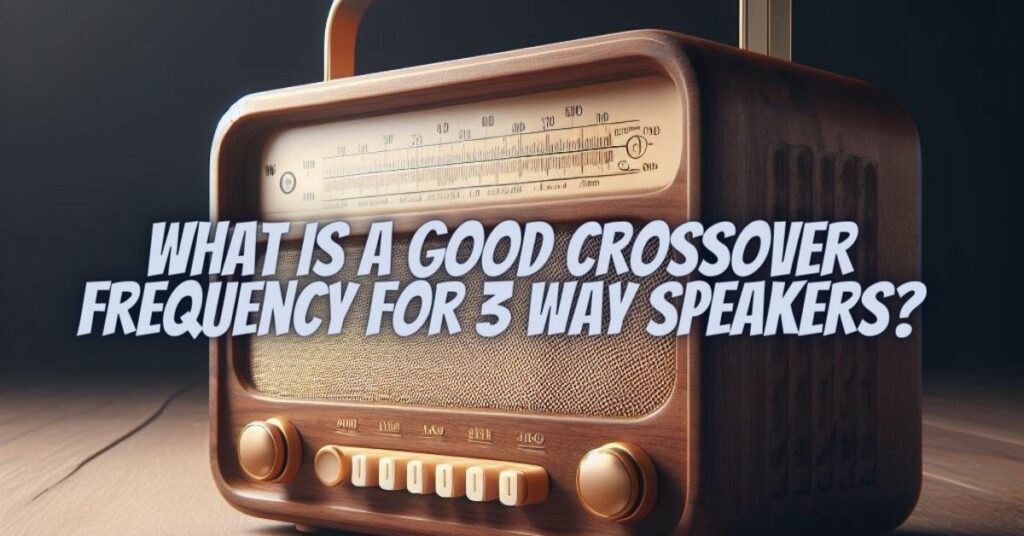Choosing the right crossover frequency for your 3-way speakers is a critical decision when building a high-quality audio system. The crossover frequency is the point at which different drivers within the speaker system take over the responsibility of reproducing specific frequency ranges. In the case of 3-way speakers, there are typically three drivers: a woofer for low frequencies, a midrange driver for mid frequencies, and a tweeter for high frequencies. This article will delve into the importance of selecting an appropriate crossover frequency, factors to consider, and how to find the optimal point for your 3-way speaker system.
Understanding Crossover Frequency
In a multi-driver speaker system like a 3-way speaker, the crossover frequency is the point at which the audio signal is split and directed to the appropriate driver for reproduction. This division ensures that each driver operates within its optimal frequency range, resulting in clearer and more accurate sound. The goal is to achieve a seamless transition between drivers without audible gaps or overlaps.
Key Components in a 3-Way Speaker System:
- Woofer: Responsible for handling low-frequency sounds, such as bass and lower midrange frequencies.
- Midrange Driver: Focuses on midrange frequencies, including vocals and instruments like guitars.
- Tweeter: Specialized in high-frequency sounds, such as cymbals, violins, and other treble elements.
Choosing the Ideal Crossover Frequency
Selecting the right crossover frequency for your 3-way speakers depends on various factors, including the characteristics of the drivers, room acoustics, and your listening preferences.
- Driver Capabilities: The first step is to consider the specifications of your individual drivers. Look at their frequency response graphs to determine their optimal operating range. This will help you decide where to set the crossover points.
- Room Acoustics: Room acoustics play a significant role in sound reproduction. Consider the size and shape of your listening space, as well as any acoustic treatment you’ve applied. Rooms with more damping materials may affect how low frequencies are perceived, which could influence your crossover settings.
- Listening Preferences: Your own preferences also matter. Do you prefer a more prominent bass response, or do you lean toward a brighter and more detailed sound? Your choice of crossover frequency will impact the overall tonal balance of the speakers.
General Guidelines for Crossover Frequencies
While the ideal crossover frequency may vary from one system to another, there are some general guidelines that can help you get started:
- Woofer-Midrange Crossover: The crossover point between the woofer and the midrange driver typically falls in the range of 100Hz to 500Hz. This range allows the midrange driver to handle the critical midrange frequencies and helps create a smoother transition between the drivers.
- Midrange-Tweeter Crossover: The crossover point between the midrange driver and the tweeter usually ranges from 1,000Hz to 5,000Hz. This selection ensures the tweeter handles high-frequency elements without distortion.
- Smooth Transitions: The key is to achieve smooth transitions between the drivers. This can be accomplished by carefully adjusting the crossover frequencies and slope characteristics (e.g., 12dB/octave or 24dB/octave). Experiment with different settings to find the best balance.
- Testing and Listening: It’s essential to audition your speakers with various types of music and content to see how well they perform. Use test tones and reference tracks to assess the frequency response, soundstage, and overall performance.
Selecting the right crossover frequency for your 3-way speakers is crucial for achieving optimal sound quality and a balanced audio experience. Carefully consider the specifications of your drivers, room acoustics, and your personal listening preferences when making this decision. A well-chosen crossover frequency will ensure that each driver operates within its optimal range, resulting in a clear, detailed, and cohesive sound that enhances your enjoyment of music, movies, and other audio content.


